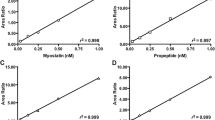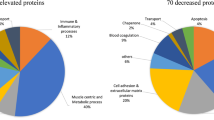Abstract
Myostatin is a highly conserved protein secreted primarily from skeletal muscle that can potently suppress muscle growth. This ability to regulate skeletal muscle mass has sparked intense interest in the development of anti-myostatin therapies for a wide array of muscle disorders including sarcopenia, cachexia and genetic neuromuscular diseases. While a number of studies have examined the circulating myostatin concentrations in healthy and sarcopenic populations, very little data are available from inherited muscle disease patients. Here, we have measured the myostatin concentration in serum from seven genetic neuromuscular disorder patient populations using immunoaffinity LC–MS/MS. Average serum concentrations of myostatin in all seven muscle disease patient groups were significantly less than those measured in healthy controls. Furthermore, circulating myostatin concentrations correlated with clinical measures of disease progression for five of the muscle disease patient populations. These findings greatly expand the understanding of myostatin in neuromuscular disease and suggest its potential utility as a biomarker of disease progression.








Similar content being viewed by others
References
Aartsma-Rus A, Ferlini A, Vroom E (2014) Biomarkers and surrogate endpoints in Duchenne: meeting report. Neuromuscul Disord NMD 24:743–745
Anaya-Segura MA, Garcia-Martinez FA, Montes-Almanza LA, Diaz BG, Avila-Ramirez G, Alvarez-Maya I, Coral-Vazquez RM, Mondragon-Teran P, Escobar-Cedillo RE, Garcia-Calderon N, Vazquez-Cardenas NA, Garcia S, Lopez-Hernandez LB (2015) Non-invasive biomarkers for duchenne muscular dystrophy and carrier detection. Molecules (Basel, Switzerland) 20:11154–11172
Awano H, Takeshima Y, Okizuka Y, Saiki K, Yagi M, Matsuo M (2008) Wide ranges of serum myostatin concentrations in duchenne muscular dystrophy patients. Clin Chim Acta 391:115–117
Ayoglu B, Chaouch A, Lochmüller H, Politano L, Bertini E, Spitali P, Hiller M, Niks EH, Gualandi F, Pontén F, Bushby K, Aartsma-Rus A, Schwartz E, Le Priol Y, Straub V, Uhlen M, Cirak S, 't Hoen PA, Muntoni F, Ferlini A, Schwenk JM, Nilsson P, Al-Khalili Szigyarto C (2014) Affinity proteomics within rare diseases: a BIO-NMD study for blood biomarkers of muscular dystrophies. EMBO mol med 6:918–936
Bergen HR 3rd, Farr JN, Vanderboom PM, Atkinson EJ, White TA, Singh RJ, Khosla S, LeBrasseur NK (2015) Myostatin as a mediator of sarcopenia versus homeostatic regulator of muscle mass: insights using a new mass spectrometry-based assay. Skelet Muscle 5:21
Bogdanovich S, Krag TO, Barton ER, Morris LD, Whittemore LA, Ahima RS, Khurana TS (2002) Functional improvement of dystrophic muscle by myostatin blockade. Nature 420:418–421
Broccolini A, Mirabella M (2015) Hereditary inclusion-body myopathies. Biochim Biophys Acta 1852:644–650
Burch PM, Pogoryelova O, Goldstein R, Bennett D, Guglieri M, Straub V, Bushby K, Lochmuller H, Morris C (2015) Muscle-derived proteins as serum biomarkers for monitoring disease progression in three forms of muscular dystrophy. J Neuromuscul Dis 2:241–255
Davies KE (1997) Challenges in Duchenne muscular dystrophy. Neuromuscul Disord NMD 7:482–486
Flanigan KM (2012) The muscular dystrophies. Semin Neurol 32:255–263
Gallardo E, Saenz A, Illa I (2011) Limb-girdle muscular dystrophy 2A. Hand Clin Neurol 101:97–110
Hathout Y, Brody E, Clemens PR, Cripe L, DeLisle RK, Furlong P, Gordish-Dressman H, Hache L, Henricson E, Hoffman EP, Kobayashi YM, Lorts A, Mah JK, McDonald C, Mehler B, Nelson S, Nikrad M, Singer B, Steele F, Sterling D, Sweeney HL, Williams S, Gold L (2015) Large-scale serum protein biomarker discovery in Duchenne muscular dystrophy. Proc Natl Acad Sci USA 112:7153–7158
Hill JJ, Davies MV, Pearson AA, Wang JH, Hewick RM, Wolfman NM, Qiu Y (2002) The myostatin propeptide and the follistatin-related gene are inhibitory binding proteins of myostatin in normal serum. J Biol Chem 277:40735–40741
Hill JJ, Qiu Y, Hewick RM, Wolfman NM (2003) Regulation of myostatin in vivo by growth and differentiation factor-associated serum protein-1: a novel protein with protease inhibitor and follistatin domains. Mol Endocrinol (Baltimore, Md) 17:1144–1154
Joulia-Ekaza D, Cabello G (2007) The myostatin gene: physiology and pharmacological relevance. Curr Opin Pharmacol 7:310–315
Lakshman KM, Bhasin S, Corcoran C, Collins-Racie LA, Tchistiakova L, Forlow SB, St Ledger K, Burczynski ME, Dorner AJ, Lavallie ER (2009) Measurement of myostatin concentrations in human serum: circulating concentrations in young and older men and effects of testosterone administration. Mol Cell Endocrinol 302:26–32
Laval SH, Bushby KM (2004) Limb-girdle muscular dystrophies–from genetics to molecular pathology. Neuropathol Appl Neurobiol 30:91–105
Mendell JR, Sahenk Z, Malik V, Gomez AM, Flanigan KM, Lowes LP, Alfano LN, Berry K, Meadows E, Lewis S, Braun L, Shontz K, Rouhana M, Clark KR, Rosales XQ, Al-Zaidy S, Govoni A, Rodino-Klapac LR, Hogan MJ, Kaspar BK (2015) A phase 1/2a follistatin gene therapy trial for becker muscular dystrophy. Mol Ther J Am Soc Gene Ther 23:192–201
Mendias CL, Lynch EB, Davis ME, Enselman ERS, Harning JA, DeWolf PD, Makki TA, Bedi A (2013) Changes in circulating biomarkers of muscle atrophy, inflammation and cartilage turnover in patients undergoing anterior cruciate ligament reconstruction and rehabilitation. Am J Sports Med 41:1819–1826
Morine KJ, Bish LT, Pendrak K, Sleeper MM, Barton ER, Sweeney HL (2010) Systemic myostatin inhibition via liver-targeted gene transfer in normal and dystrophic mice. PLoS One 5:e9176
Nakatani M, Takehara Y, Sugino H, Matsumoto M, Hashimoto O, Hasegawa Y, Murakami T, Uezumi A, Takeda S, Noji S, Sunada Y, Tsuchida K (2008) Transgenic expression of a myostatin inhibitor derived from follistatin increases skeletal muscle mass and ameliorates dystrophic pathology in mdx mice. FASEB J Off Publ Fed Am Soc Exp Biol 22:477–487
Nigro G, Papa AA, Politano L (2012) The heart and cardiac pacing in Steinert disease. Acta Myologica 31:110–116
Nigro V, Savarese M (2014) Genetic basis of limb-girdle muscular dystrophies: the 2014 update. Acta Myol Myopathies Card Off J Mediterr Soc Myol 33:1–12 (edited by the Gaetano Conte Academy for the study of striated muscle diseases)
Ozawa E, Hagiwara Y, Yoshida M (1999) Creatine kinase, cell membrane and Duchenne muscular dystrophy. Mol Cell Biochem 190:143–151
Palandra J, Quazi A, Fitz L, Rong H, Morris C, Neubert H (2016) Quantitative measurements of GDF-8 using immunoaffinity LC-MS/MS. Proteom Clin Appl 10:597–604
Partridge TA (2013) The mdx mouse model as a surrogate for Duchenne muscular dystrophy. FEBS J 280:4177–4186
Phillips MF, Quinlivan RC, Edwards RH, Calverley PM (2001) Changes in spirometry over time as a prognostic marker in patients with Duchenne muscular dystrophy. Am J Respir Crit Care Med 164:2191–2194
Ratkevicius A, Joyson A, Selmer I, Dhanani T, Grierson C, Tommasi AM, DeVries A, Rauchhaus P, Crowther D, Alesci S, Yaworsky P, Gilbert F, Redpath TW, Brady J, Fearon KC, Reid DM, Greig CA, Wackerhage H (2011) Serum concentrations of myostatin and myostatin-interacting proteins do not differ between young and sarcopenic elderly men. J Gerontol Ser A Biol Sci Med Sci 66:620–626
Ricotti V, Ridout DA, Pane M, Main M, Mayhew A, Mercuri E, Manzur AY, Muntoni F (2016) The NorthStar Ambulatory Assessment in Duchenne muscular dystrophy: considerations for the design of clinical trials. J Neurol Neurosurg Psychiatry 87:149–155
Ruegg UT (2013) Pharmacological prospects in the treatment of Duchenne muscular dystrophy. Curr Opin Neurol 26:577–584
Saremi A, Gharakhanloo R, Sharghi S, Gharaati MR, Larijani B, Omidfar K (2010) Effects of oral creatine and resistance training on serum myostatin and GASP-1. Mol Cell Endocrinol 317:25–30
Sartori R, Gregorevic P, Sandri M (2014) TGFbeta and BMP signaling in skeletal muscle: potential significance for muscle-related disease. Trends Endocrinol Metab Tem 25:464–471
Schuelke M, Wagner KR, Stolz LE, Hubner C, Riebel T, Komen W, Braun T, Tobin JF, Lee SJ (2004) Myostatin mutation associated with gross muscle hypertrophy in a child. N Eng J Med 350:2682–2688
Spurney C, Shimizu R, Morgenroth LP, Kolski H, Gordish-Dressman H, Clemens PR (2014) Cooperative International Neuromuscular Research Group Duchenne Natural History Study demonstrates insufficient diagnosis and treatment of cardiomyopathy in Duchenne muscular dystrophy. Muscle Nerve 50:250–256
Szulc P, Schoppet M, Goettsch C, Rauner M, Dschietzig T, Chapurlat R, Hofbauer LC (2012) Endocrine and clinical correlates of myostatin serum concentration in men–the STRAMBO study. J Clin Endocrinol Metab 97:3700–3708
Thornton CA (2014) Myotonic dystrophy. Neurologic clinics 32:705–719 (viii)
Tobin JF, Celeste AJ (2005) Myostatin, a negative regulator of muscle mass: implications for muscle degenerative diseases. Curr Opin Pharmacol 5:328–332
Wagner KR, Fleckenstein JL, Amato AA, Barohn RJ, Bushby K, Escolar DM, Flanigan KM, Pestronk A, Tawil R, Wolfe GI, Eagle M, Florence JM, King WM, Pandya S, Straub V, Juneau P, Meyers K, Csimma C, Araujo T, Allen R, Parsons SA, Wozney JM, Lavallie ER, Mendell JR (2008) A phase I/IItrial of MYO-029 in adult subjects with muscular dystrophy. Ann Neurol 63:561–571
Walker RG, Poggioli T, Katsimpardi L, Buchanan SM, Oh J, Wattrus S, Heidecker B, Fong YW, Rubin LL, Ganz P, Thompson TB, Wagers AJ, Lee RT (2016) Biochemistry and biology of GDF11 and myostatin: similarities, differences, and questions for future investigation. Circ Res 118:1125–1142
Walter MC, Reilich P, Thiele S, Schessl J, Schreiber H, Reiners K, Kress W, Muller-Reible C, Vorgerd M, Urban P, Schrank B, Deschauer M, Schlotter-Weigel B, Kohnen R, Lochmuller H (2013) Treatment of dysferlinopathy with deflazacort: a double-blind, placebo-controlled clinical trial. Orphanet J Rare Dis 8:26
Wang LH, Tawil R (2016) Facioscapulohumeral dystrophy. Curr Neurol Neurosci Rep 16:66
White TA, LeBrasseur NK (2014) Myostatin and sarcopenia: opportunities and challenges—a mini-review. Gerontology 60:289–293
Yarasheski KE, Bhasin S, Sinha-Hikim I, Pak-Loduca J, Gonzalez-Cadavid NF (2002) Serum myostatin-immunoreactive protein is increased in 60–92 year old women and men with muscle wasting. J Nutr Health Aging 6:343–348
Zaharieva IT, Calissano M, Scoto M, Preston M, Cirak S, Feng L, Collins J, Kole R, Guglieri M, Straub V, Bushby K, Ferlini A, Morgan JE, Muntoni F (2013) Dystromirs as serum biomarkers for monitoring the disease severity in Duchenne muscular Dystrophy. PLoS One 8:e80263
Acknowledgements
This work was supported by the EU funded projects BIO-NMD (No.241665), Neuromics (No. 305121) and RD-Connect (305444) and by the Medical Research Council (MRC) Centre for Neuromuscular Diseases Biobanks (Newcastle) which are part of EuroBioBank; we are grateful to Dan Cox and Mojgan Reza for technical support at the biobank and Karen Bettinson for support with phenotype data. We thank the Jain foundation for providing the LGMD2B patient samples and their helpful comments. We thank the Predictive Safety Testing Consortium of the Critical Path Institute for their contribution of healthy control serum samples.
Author information
Authors and Affiliations
Corresponding author
Ethics declarations
Conflicts of interest
The authors declare that they have no conflicts of interest.
Ethical standards
All studies involving human samples were conducted in accordance with the Declaration of Helsinki on Ethical Principles for Medical Research Involving Human Subjects and in accordance with a protocol which was approved by the local Institutional Review Board. All animals were handled in compliance with the NIH and institutional guidelines that were approved by the Institutional Animal Care and Use Committee Pfizer, Inc (Groton, CT, USA).
Additional information
P. M. Burch, O. Pogoryelova and J. Palandra contributed equally to this work.
Electronic supplementary material
Below is the link to the electronic supplementary material.
Rights and permissions
About this article
Cite this article
Burch, P.M., Pogoryelova, O., Palandra, J. et al. Reduced serum myostatin concentrations associated with genetic muscle disease progression. J Neurol 264, 541–553 (2017). https://doi.org/10.1007/s00415-016-8379-6
Received:
Revised:
Accepted:
Published:
Issue Date:
DOI: https://doi.org/10.1007/s00415-016-8379-6




